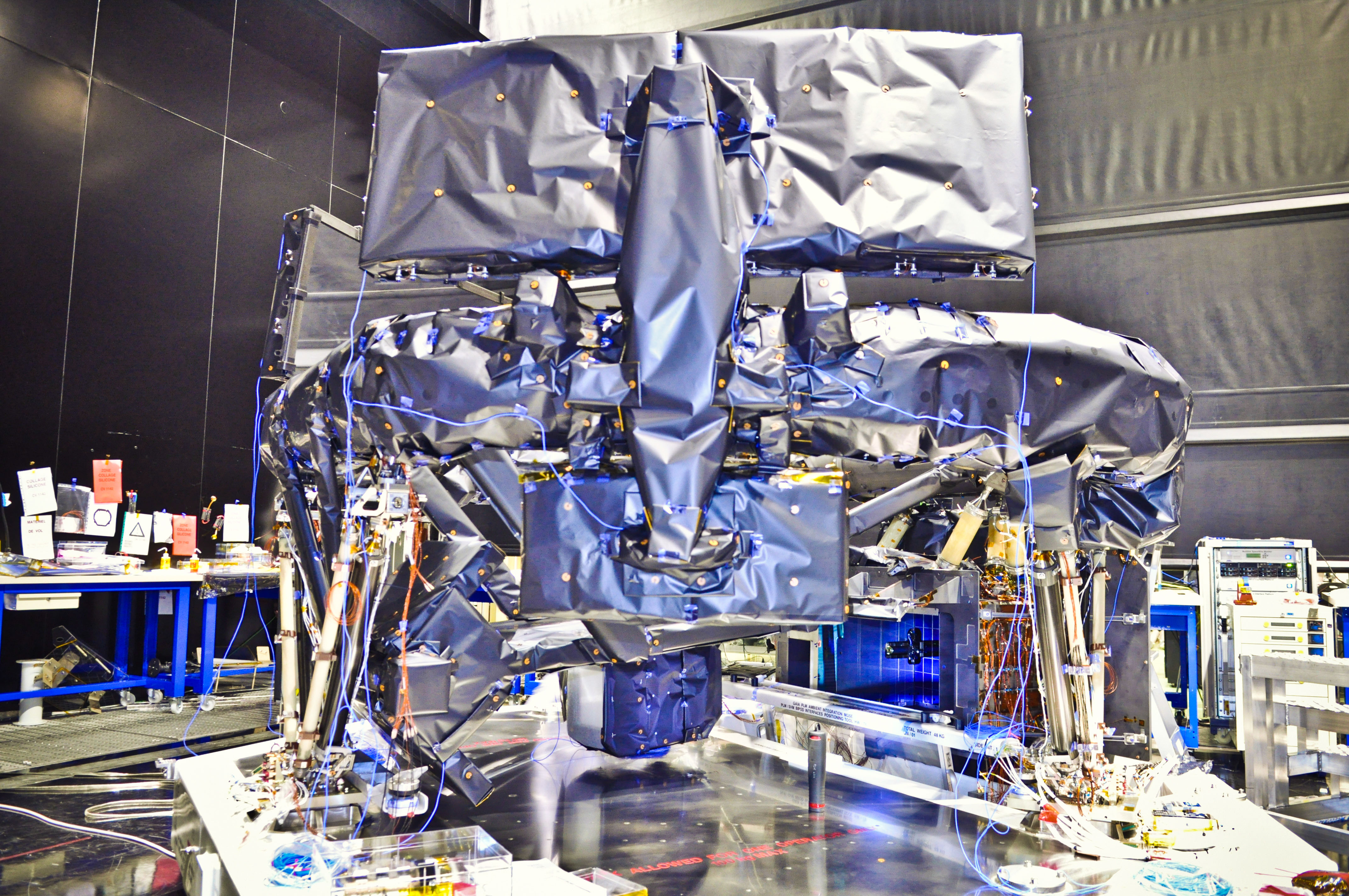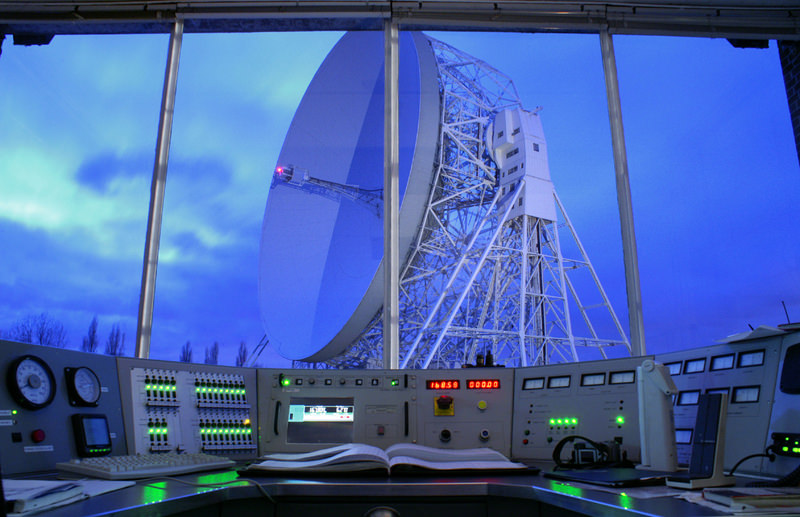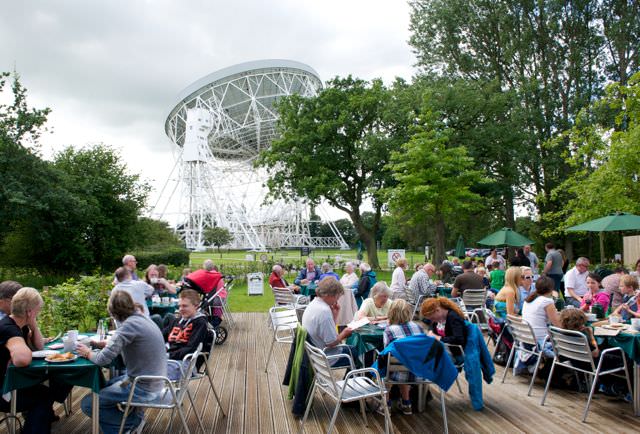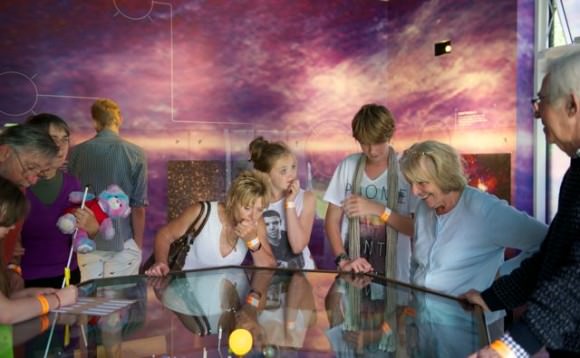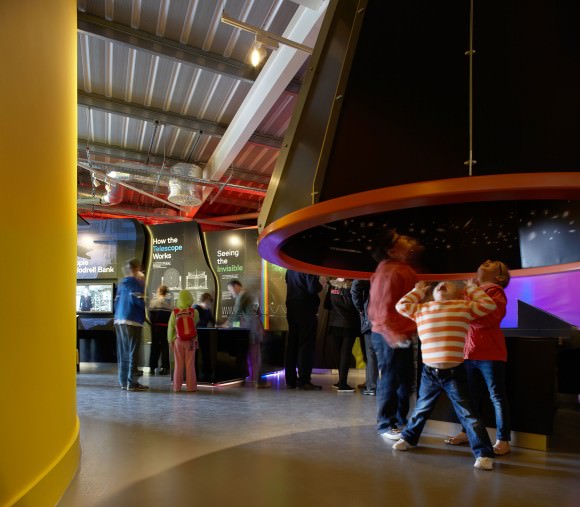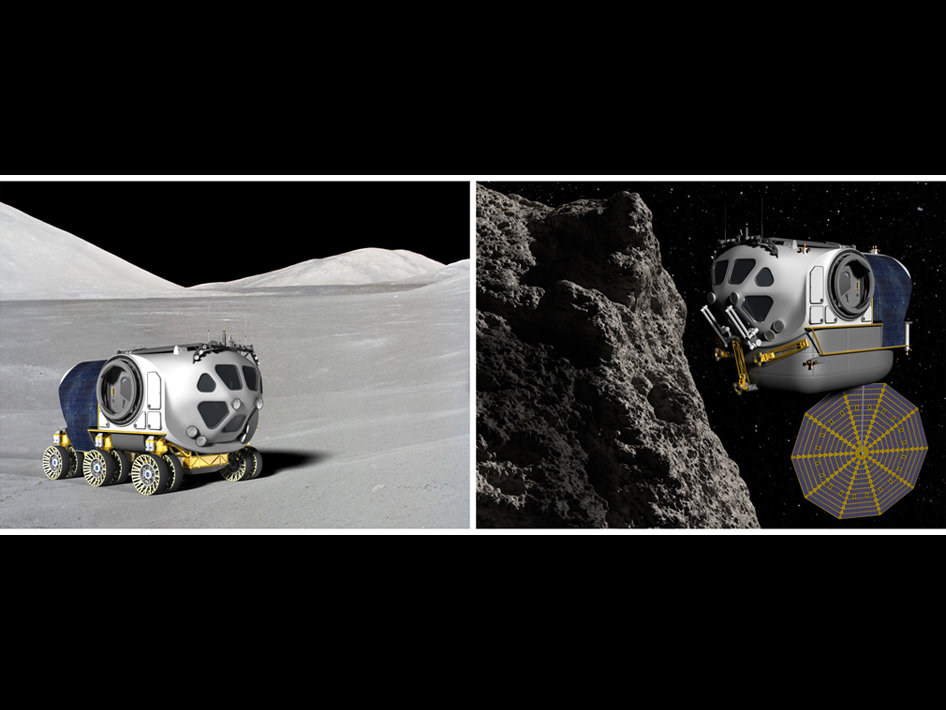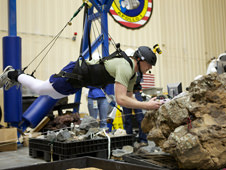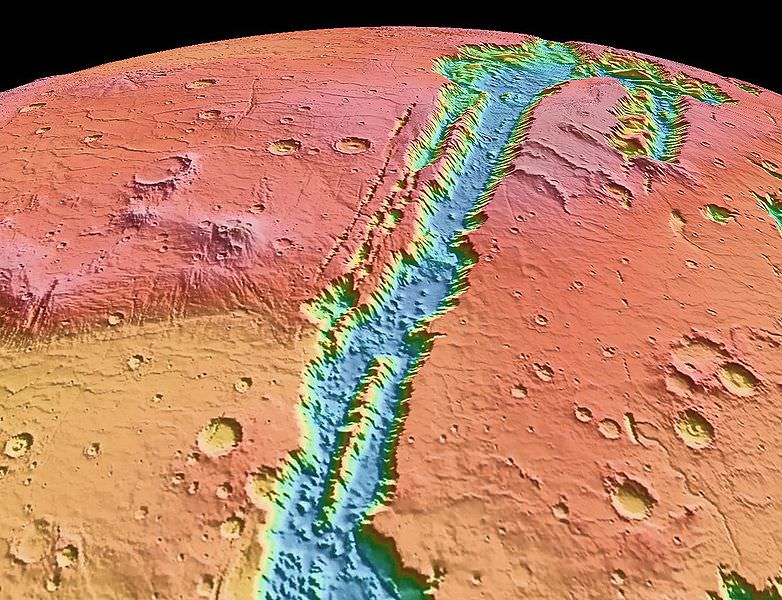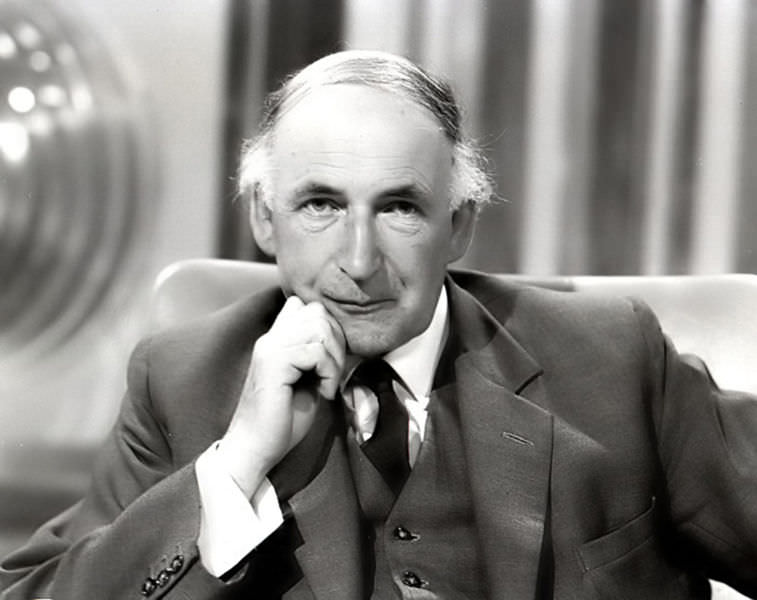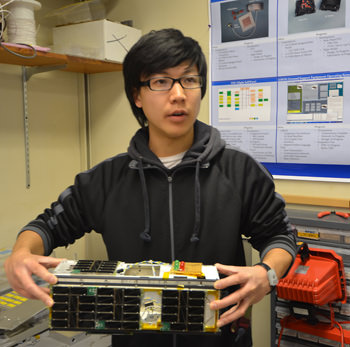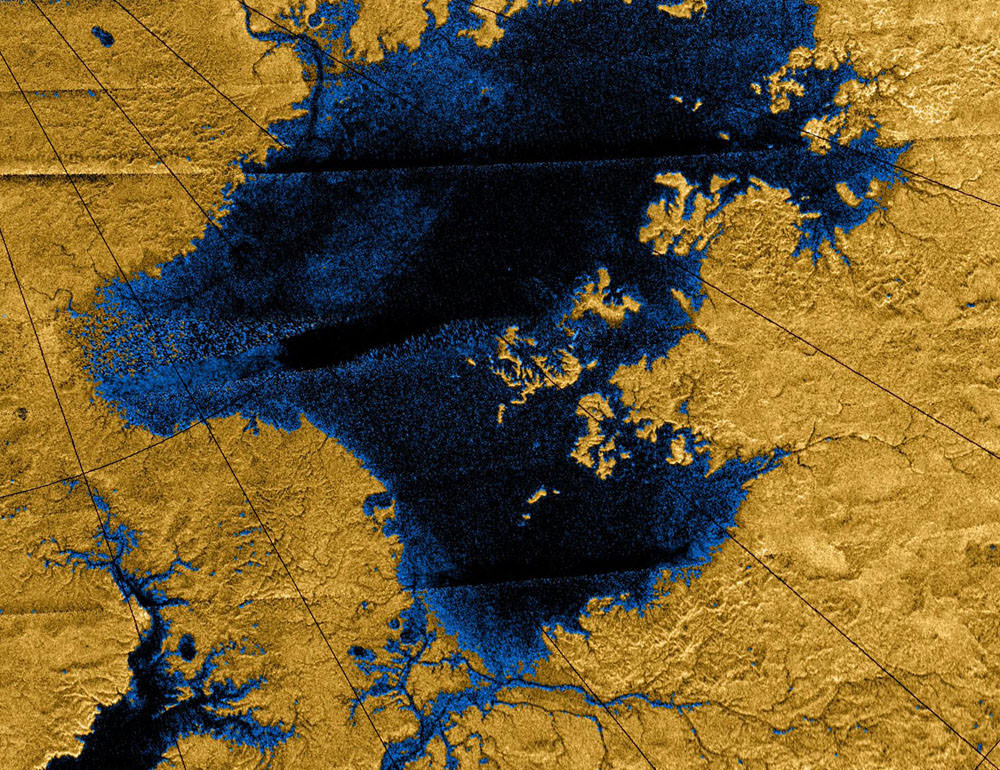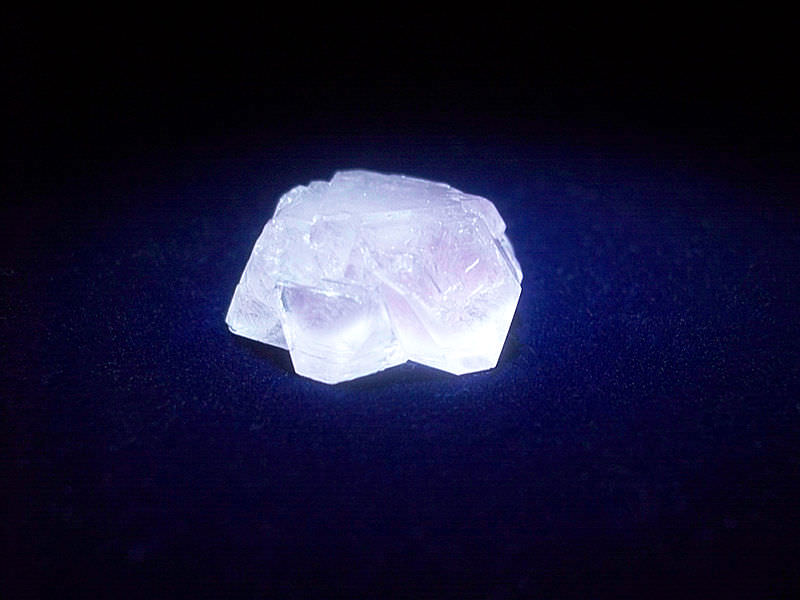Caption: The original Jodrell Bank Control Desk with view of the Lovell telescope. Credit: Anthony Holloway.
Last week we took a look at the public face of the Jodrell Bank Observatory, the Discovery Centre. But this week we get a behind-the-scenes tour of the heart of this impressive and historic observatory.
Dr. Tim O’Brien is Associate Director of the Jodrell Bank Observatory and a Reader in Astrophysics in the School of Physics & Astronomy at the University of Manchester. As we begin our tour of the telescopes, control room and computers he explains the role of Jodrell in the historical development of radio astronomy. The Lovell telescope at the heart of the observatory, is today a Grade 1 listed building as well as being at the cutting edge of current, and indeed future, scientific research.
Jodrell Bank was originally the site of the university Botany Department’s testing ground. The Observatory was founded by Sir Bernard Lovell when interference from trams disrupted the research into cosmic rays that he was carrying out in the School of Physics at the University’s main campus in the city. Sir Bernard moved his radar equipment to the site in 1945 to try to find radio echoes from the ionized trails of cosmic rays but instead founded a whole new area of research into meteors.
The Lovell telescope (originally the Mark I) was the largest steerable radio telescope in the world (76.2m in diameter) and the only one able to track the launch rocket of Sputnik 1 in 1957; it is still the third largest in the world. Apart from tracking and receiving data from such probes as Pioneer 5 in 1960 and Luna 9 in 1966, a continual programme of upgrades enabled the scope to measure distances to the Moon and Venus and research pulsars, astrophysical masers, quasars and gravitational lenses. It has provided the most extensive studies of pulsars in binary star systems and discovered the first pulsar in a globular cluster. It detected the first gravitational lens and has also been used for SETI observations. Now on its third reflecting surface, a continual programme of upgrades has made it more powerful than ever.
In 1964 the Mark II elliptical radio telescope was completed. It stands in the middle of a field, dwarfing the small observing dome that house Tim’s optical teaching telescope and surrounded by post war huts named after the research that was done in them, so one is called Radiant (after meteors) and another Moon. With a major axis of 38.1m and minor axis of 25.4m the Mark II is mainly used alongside the Lovell as part of e-MERLIN (Multi Element Radio Linked Interferometer Network), the UK’s national radio astronomy facility run from Jodrell. This comprises up to 7 radio scopes: the Lovell, Mark II, Cambridge, Defford, Knockin, Darnhall and Pickmere. e-MERLIN has the longest baseline (separation of telescopes) of 217 Km and a resolution of better than 50 milliarcseconds, which compares with the Hubble Space Telescope but at radio rather than visible wavelengths. The Manchester branch of Jodrell also hosts the UK Regional Centre Node for ALMA (the Atacama Large Millimetre/sub-millimetre Array) in Chile.
The “42ft “ telescope stands by the entrance to the main building that houses the control room. The telescopes main task is to continually monitor the Pulsar at the heart of the Crab Nebula (all the time it is above the horizon). Tim at this point showed off his impressive party trick of mathematically demonstrating that the scope was indeed pointing at the Crab Pulsar by calculating from the pulsar’s Right Ascension ( 05h 34m 31.97s ) and Declination (+22d 00m 52.1s) where it would be in the sky at the time. It has collected over 30 years of data which represents 4% of the pulsar’s age, giving vital clues about how pulsars evolve.
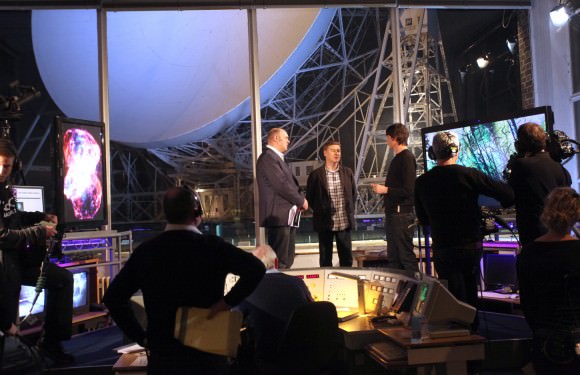
Caption: Dr Tim O’Brien talking to Prof. Brian Cox and Dara O’Biain in the Control Room during Stargazing Live Credit: The University of Manchester
Tim was kind enough to allow me inside the Control Room, not often seen by general visitors to the site, though it plays host to BBC TV’s annual Stargazing Live series, hosted by Prof. Brian Cox and Dara O’Briain. It perfectly illustrates Jodrell historical and current role in radio astronomy. It is a wonderfully British mix of state of the art computer technology, original 1950’s equipment and all points between. There are massive flat screen monitors in one corner that display & can control each of the scopes, an atomic clock alongside wood and glass cabinets housing twitching needles that trace out air pressure, wind speed and temperature variations on rolls or discs of paper. In the centre of the room is the original horseshoe shaped control desk from the 1950s.
The vast window overlooks the Lovell scope which was ‘parked’ during my visit whilst the reflecting bowl was being given a new coat of paint, pointing straight up to the zenith with the brakes applied. If the winds increase during an observation the dish has to be raised and moved to a target higher in the sky. If the winds reach 45 miles per hour the dish has to be parked in this upright position. Luckily this doesn’t happen too often. A heavy accumulation of snow could distort the shape of the dish so it has to be tipped out. The control room is manned 24 hours a day 365 days of the year. The whole room has a very satisfying amount of blinking lights, dials, knobs and switches. As Tim rightly says “You need plenty of flashing lights.”
Jodrell houses a number of general-purpose and specialised computing clusters. Since the 1960s the Lovell and Mark II have been regularly involved with VLBI (Very Long Baseline Interferometry) which includes telescopes across Europe, China and Africa and can also be linked to the VLBA (Very Long Baseline Array) in America to create a telescope the size of the planet, able to produce the sharpest images in all astronomy. The VLBI room houses a huge array of receiver and recording equipment. This includes a GPS receiver, accurate to 0.5 millisec, affectionately known as the Totally Accurate Clock, though they have newer ones with 25 nanosecond accuracy and their maser atomic clock is accurate to 1 part in 10^15 or 1 second every 30 million years! Names are quite the thing at Jodrell, five signal generators, used to convert frequencies in the receiver are neatly labelled Sharon, Tracy, Nigel, Kevin and Darren.
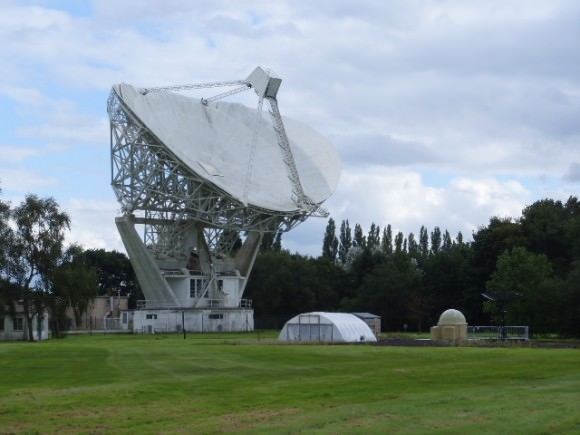
Caption: The Mark II telescope at Jodrell Bank. Credit: The Author
Jodrell pioneered the connection of radio telescopes across hundreds of kilometres and constructed the dedicated optical fibre network that connects all seven e-MERLIN telescopes. Tim paused for effect in front of an impressively large and heavy-duty blue door that was adorned with numerous dramatic warning signs and hummed ominously, with his hand on a sturdy operating lever. This was the home of the e-MERLIN correlator, the focus of all seven telescopes and the heart of the network, it has to be carefully shielded so it doesn’t interfere with the radio scopes on site. Tim tapped in the entry code, pulled the lever and the gentle hum became a deafening roar as we entered a metal room, kept cold with air-conditioning. There are massive cylinders of gas in the corner ready to fill the room in case of fire. In the centre is a smoked glass cabinet, the size of a large wardrobe containing the computer hub with festoons of yellow optic fibre cables linked to the telescopes and bringing as much data into the room as travels on the rest of the UK internet combined.
Jodrell has about 40 staff on the site with over 100 more working from the University’s Alan Turing Building in Manchester. The group’s list of research programmes covers all aspects of astronomy, from studying the Big Bang to discovering exoplanets. They have used pulsars to test Einstein’s theory of gravity for which they were awarded the EC Descartes Research Prize. They developed low-noise amplifiers for ESA’s Planck spacecraft which will report its cosmology results next year. With a European network of radio telescopes they are using pulsars to attempt the first detection of gravitational waves predicted by Einstein.
Looking to the future, work is now underway alongside the main Control Building on the construction of a new building to house the International Project Office for SKA (the Square Kilometre Array) to be sited in Africa and Australia, that when completed in around 2024, will be the World’s largest radio telescope for the 21st century. As we are leaving I ask Tim what would be on his wish list for the future (all astronomers have a wish list don’t they?) He would like to see a system like SKA extended to cover the Northern hemisphere and a future telescope which could make real-time, whole-sky observations, instantly targeting transient objects such as the novae that are the main focus of his own research. I think Sir Bernard would approve.
Find out more about the Jodrell Bank Centre for Astrophysics

